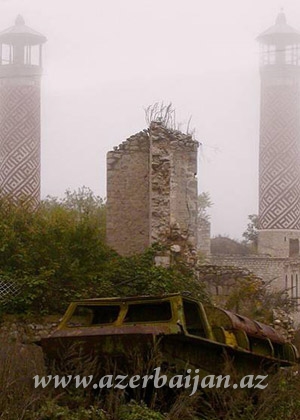Report on damage to Azeri Islamic monuments to be issued

By Sara Rajabova
The Azerbaijani state body overseeing religious organizations intends to submit a report on the destruction of Islamic monuments in Armenia and in the occupied territories of Azerbaijan to the international community, a local news agency reported.
Elshad Isgandarov, chairman of the State Committee for Work with Religious Organizations, noted that numerous historical and Islamic monuments of the Azerbaijani people are being destroyed in Armenia.
Azerbaijan and Armenia fought a lengthy war that ended with the signing of a precarious cease-fire in 1994. Armenian armed forces have since occupied over 20 percent of Azerbaijan's internationally recognized territory, including Nagorno Karabakh, defying international calls and UN resolutions.
After invading Azerbaijan's territories Armenia has been pursuing the campaign of ruining cultural and historical monuments of the Azerbaijani people. The Armenians are also appropriating monuments of the ancient Caucasus Albania. A variety of ancient Albanian scripts, wall designs and crosses have been replaced by Armenian attributes. A number of mosques are used as store-houses. Buildings as well as unique exhibits of the museums located in the occupied Azerbaijani lands have been either destroyed or used as a basis for new museums, and the Armenians thus claim they belong to them.
The first human dwellings like the well-known Azykh and Taghlar caves, the Garakopak and Uzarliktapa burial mounds, located in the occupied territories, are being used for military purposes and destroyed. Cemeteries, mausoleums, monuments, mosques, temples and monuments that once belonged to Caucasus Albania and other cultural heritage sites in the occupied regions of Shusha, Lachin, Kalbajar, Gubadli, Zangilan, and Fuzuli have been destroyed along with burial mounds in Khojaly, Aghdam, Aghdara, Fuzuli and Jabrayil.
The destruction of Azerbaijani cultural monuments in the occupied territories continues to this day. The invaders are carrying out large-scale archeological excavations, destroying burial mounds. Remaining in the Azerbaijani territories occupied by Armenia -- Nagorno-Karabakh and the surrounding regions -- are 13 architectural and archeological monuments of global importance, 292 monuments of state importance and 330 of local importance, as well as 23 parks, and 15 decorative art samples.
Moreover, 22 museums with 40,000 exhibits, 927 libraries, 808 clubs, four theaters, two concert halls, eight culture and recreation parks, four picture galleries, 85 music schools, etc. remain under occupation.
Total damage inflicted to Azerbaijan amounts to $6.7 billion, according to approximate calculations based on the documents of 1994. The figure excludes items of intangible heritage, and it is impossible to determine the immense moral value of these destroyed, ancient and irreplaceable cultural monuments of the Azerbaijan people.
Preservation of historical and cultural monuments in the Armenia-occupied territory of Azerbaijan as memory of the nation's centuries-old history is a matter of international importance, because the Azerbaijani people's cultural heritage is an integral part of the world culture.
The destruction and intentional damage to the historical and cultural monuments by the Armenian invaders in the occupied territories of Azerbaijan contradict the 1954 Hague convention on preservation of cultural values during armed conflicts, the 1992 European convention on preservation of archeological heritage, and the 1972 UNESCO convention on preservation of world cultural and natural heritage.
"The State Committee is preparing a report on the destruction of Islamic monuments in Armenia and in the occupied territories of Azerbaijan. The report will be submitted to the international community soon," Isgandarov said.
"The people of Azerbaijan approach religious confessions, as well as religious monuments of Armenia in line with the values of tolerance," Isgandarov noted with regard to the protection of the Armenian Church in Baku.
Based on archive documents he also said Armenian Apostolic Church Echmiadzin had never had a branch in the territory of Nagorno-Karabakh.
"Archive documents show that the main temple of the Armenian Apostolic Church, Echmiadzin, had no branch in Nagorno-Karabakh," Isgandarov said. "Only in mid-19th century, the Albanian church in Karabakh was granted to the Armenians...The Armenians savagely wiped out the archive in the Albanian church. However, it is impossible to blot out history. Seven or eight years ago, a document was discovered on the Sinai Peninsula, Egypt concerning the Albanian church. The ancient "Evangelic" [item] belonging to the Albanian church is being studied by specialists. We will submit these facts to the international community.
"On the basis of ancient documents we will prove that the Albanian church had formed in the ancient Azerbaijani lands and was the cultural and spiritual heritage of the Udin community of Azerbaijan," Isgandarov added.
The occupation of Azerbaijani lands and making any desired changes there is unacceptable from the point of view of contemporary international law. According to international law, all the resources in Nagorno-Karabakh and the surrounding regions continue to be a property of Azerbaijan.
Here we are to serve you with news right now. It does not cost much, but worth your attention.
Choose to support open, independent, quality journalism and subscribe on a monthly basis.
By subscribing to our online newspaper, you can have full digital access to all news, analysis, and much more.
You can also follow AzerNEWS on Twitter @AzerNewsAz or Facebook @AzerNewsNewspaper
Thank you!
